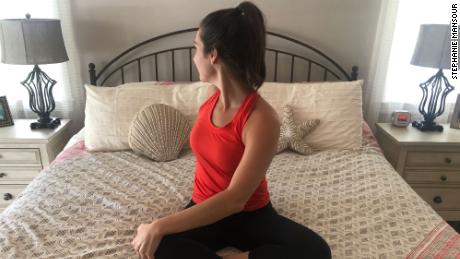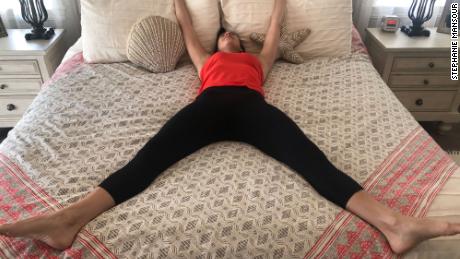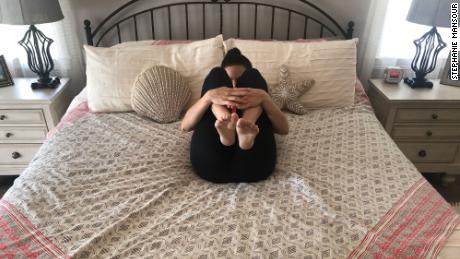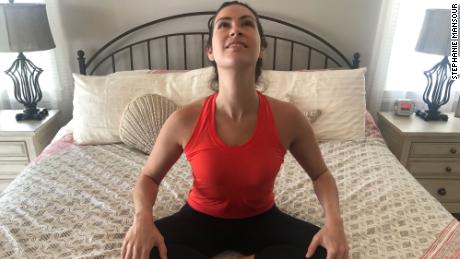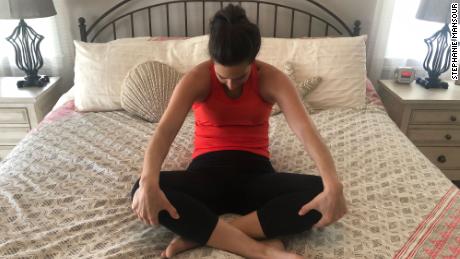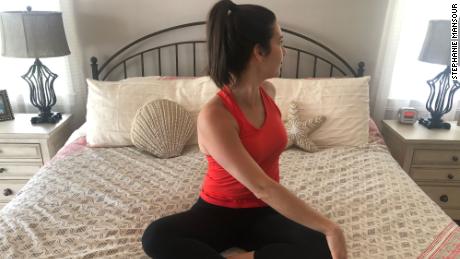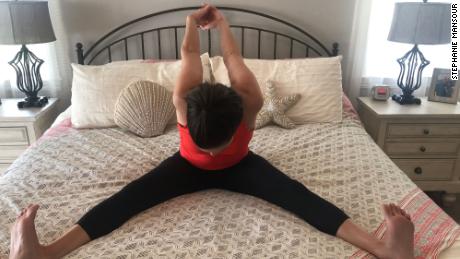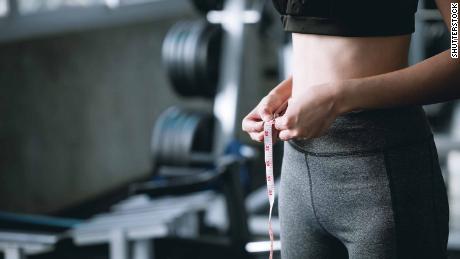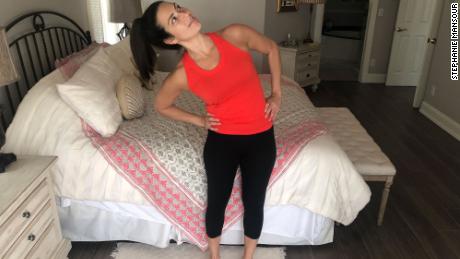(CNN)The countless hours that many of us have spent sitting at a makeshift desk in quarantine can be detrimental not only physically but also mentally. Hunched over a computer day in and day out, you're not just wreaking havoc on your posture, but you're likely feeling out of sorts and drained, too.
If you're waking up feeling stressed or overwhelmed with the thought of beginning another day in isolation, a daily yoga practice can be helpful. Practicing brief sessions of yoga and mindfulness can significantly improve energy levels and brain function.
Along with the physical practice of yoga, the breathwork, called pranayama, has a significant positive impact on energy levels and cognitive function. Research has shown that slow, steady breathing linked with movement helps reduce stress and improve autonomic and higher neural center functioning.
Think about a yoga practice as a cup of coffee: You turn to coffee because it tastes good and makes you feel sharper mentally. Similarly, you can turn to yoga because it feels good and helps you feel more energetic. But if you're intimidated by the idea of a long class or are worried that you don't have enough experience to begin yoga, have no fear.
Quarantine can be a great time to start a brief, daily practice first thing in the morning.
Need more reasons to start? Here's some inspiration: A collection of studies reported that regular practice of yoga improves serotonin levels, decreases depression and anxiety, increases blood flow, allowing more oxygen to reach the body cells and thus enhancing their function, and improves flexibility and functional mobility in people with chronic pain.
That's why I created this five-minute yoga routine to loosen up your body and start your day off feeling calm, balanced and positive. As a certified yoga instructor for over a decade, I encourage my clients to engage in a daily yoga practice (preferably in the morning) to get the blood flowing, boost energy and invigorate the senses.
These poses are strategically included because they open up the body physically, improve blood flow to the vital organs and stretch the front, back and sides of the body in a short amount of time.
Practice all of these poses with the pranayama breath: Breathe in through your nose and out through your nose. Breathe slowly and mindfully, and sync your breath with your movements.
Lying-down starfish pose
Similar to standing goddess pose, lying down in a starfish position opens up the chest, lungs, back and torso. To perform this pose, simply reach your arms overhead while lying in bed, and stretch your legs out long. Open your legs wider than your hips, and open your arms out further than your shoulders. Stretch through your fingers and toes as far as you can.
For an added bonus, curl up into a ball by hugging your knees into your chest and curling your head up toward your knees. Release and come back into starfish pose. Repeat this five times. Inhale as you open up into starfish pose, and exhale as you curl up, hugging your knees into your chest.
The compression of internal organs as you curl up into a ball squeezes the organs in the front of your body; as you release, fresh blood and oxygen floods these areas while you're expanding into starfish pose.
Seated cat and cow pose
Now come up to a cross-legged seated position on your bed. Place your hands palms down on your knees. Sit up tall as you lift your chest, arch your low back and press your hands into your knees to lift your torso. Inhale here.
Exhale as you round your back, pulling your naval in toward your spine and holding onto your knees to pull your spine away from your knees. Drop your chin toward your chest. Repeat this five times.
This pose improves mobility and flexibility in the spine and also opens up the chest. This movement stimulates the lungs while stretching the chest, and stretches the back of the body to help with stiff or sore upper- and lower-back issues.
Seated twist
Sitting cross-legged, inhale and reach your arms up toward the ceiling. Exhale as you twist to the right, and place your left hand on your right knee and your right fingertips behind you on the bed. Inhale to lift up taller, and exhale to pull your naval in toward your spine to twist further, looking over your right shoulder. Hold for three slow, deep breaths, and then release. Repeat to the left side.
Twists, like the first pose of this sequence, allow fresh oxygen and nutrients to flow to the internal organs upon release. Furthermore, twisting stimulates blood circulation and helps release tension in the abdominal area. Twists open up the upper back and counteract slumped posture.
Seated wide-leg forward fold with clasped hands
Sitting upright, open your legs out as wide as you can. It may be helpful to prop yourself up and sit on a pillow if your legs ŌĆö or low back ŌĆö are very tight. Flex your feet, and engage your quads. Next, clasp your hands behind your back to open up your shoulders and your chest. Inhale as you sit up tall, and then exhale to slowly fold forward.
If you are brand-new to yoga or very inflexible, you may not lean over very far. Hold this position wherever you are to feel a stretch in your inner thighs and chest. Hold for three slow, deep breaths.
This upper body stretch provides an opportunity to not only improve posture by bringing the shoulders back, but also improve lung capacity by expanding the rib cage freely as you breathe in. The lower-body stretch focuses on loosening up the hips and inner thighs that are often tight from sitting for extended periods of time.
Standing side stretch
Time to rise and shine! Stand up next to your bed and place your feet on the ground as wide as your hips. Place both hands on your hips, and slowly lean to the right. Press down with your left foot as you feel a stretch along the left side of your body. Inhale here to expand the left side of your body, and exhale as you come up to center. Inhale to lean over to the left to stretch the right side of your body, and exhale as you come up to center.
Repeat this three times to each side.
Get CNN Health's weekly newsletter
Sign up here to get The Results Are In with Dr. Sanjay Gupta every Tuesday from the CNN Health team.
This yoga pose improves flexibility in the torso and wakes up the side-to-side movement of the spine. It also stretches the intercostal muscles between the ribs, which can improve breathing.
This energizing yoga routine can be performed daily to train your body and mind to stress less, release tension, feel more relaxed and use your breath to cultivate more space mentally and physically.

